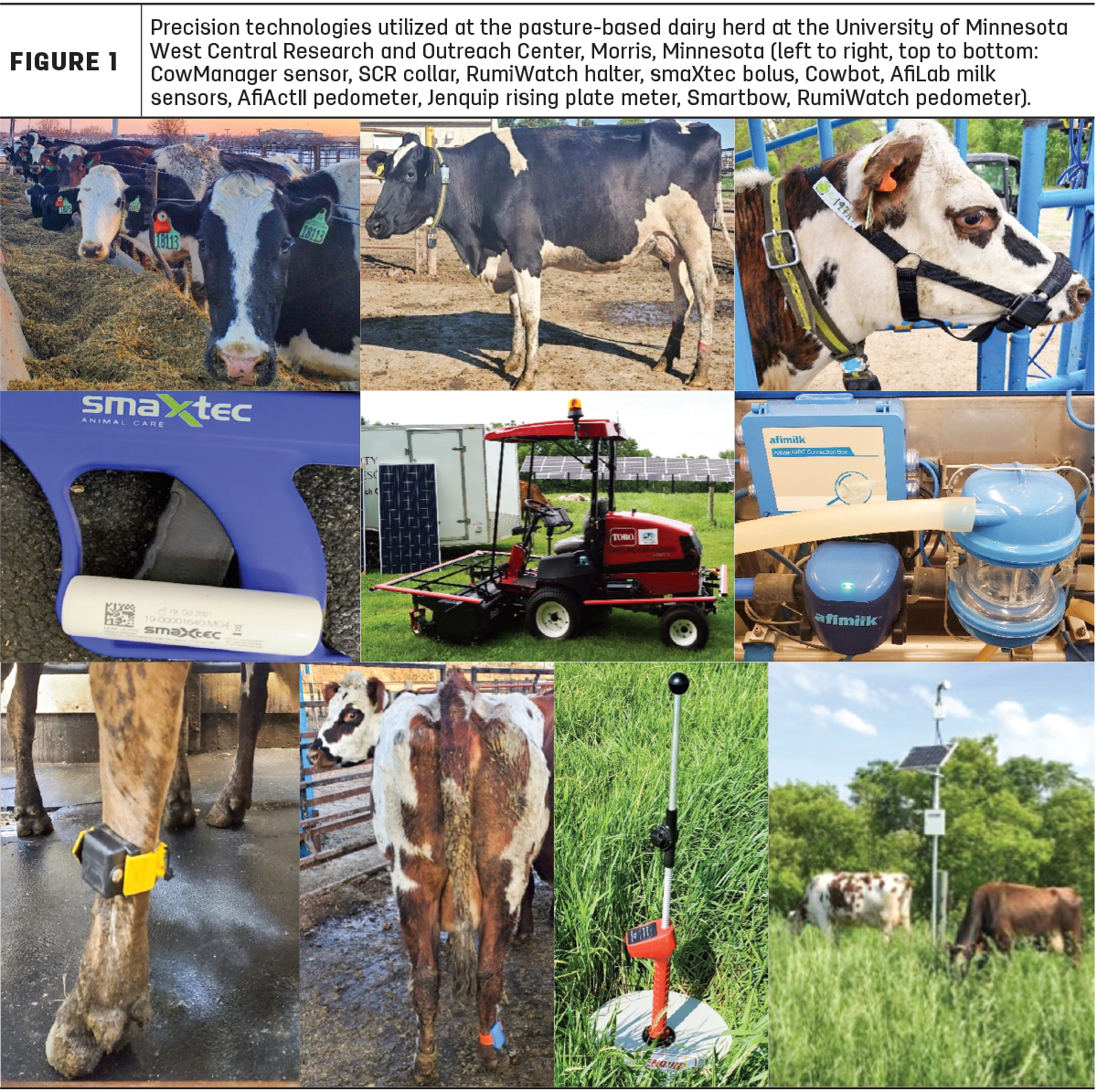Pasture-based dairy herds continue to grow in the U.S. as the demand for grass-fed and continued sustainable farming practices increases. Sustainable farming practices may be achieved with confinement dairy herds; however, the increased expense of dairy farming has caused farmers to adopt different management styles within their dairy herds. Animal welfare and cow comfort must be a priority within pasture-based dairy herds; however, unlike in confinement herds, cattle are not always within eyesight of employees. Therefore, precision dairy technologies allow for cattle to be monitored continuously without constant human observation. Monitoring daily behaviors such as feeding, ruminating, resting or lying, and active time can aid in understanding animal health and productivity. Farmers who want to increase overall production efficiency should consider implementing precision technologies.
The goals of precision technologies for dairy grazing systems include increased animal performance through enhanced milk production, increased fertility, improved animal health, reduced transition disorders, reduced lameness and increased utilization of pasture through improved grazing patterns and behavior of cattle. Precision dairy technologies for grazing dairies have received a lot of attention because of advances in continuous monitoring of animal behavior and health of cattle on pasture, robotics, computer vision and machine learning techniques. This article summarizes the current research and status of precision technologies for grazing dairy herds with wearable technologies, pasture forage measurements and grazing management, and autonomous and unmanned vehicles. Figure 1 has precision technologies that are available to grazing dairy farmers and utilized at the University of Minnesota West Central Research Center’s pasture-based dairy herd.

Wearable technologies for grazing cattle
There are more than 50 wearable technologies that have been developed and marketed for dairy cattle. Many technologies are worn by the cow and may be reused, whereas some are placed inside the cow and may not be reused. Cow behavior data such as eating time, ruminating time, lying time and standing time may be continuously collected by the precision technologies. Once data is processed through algorithms, it can be categorized into specific behaviors or health and estrus alerts. The data can then be viewed on a computer system, on a website, and some companies have applications for mobile devices. There is a need to improve welfare and efficiency and utilize behaviors to study grazing patterns as well as determine how heat stress can affect cattle on pasture.
The research team at the West Central and Outreach Center has validated wearable technologies for grazing cows and found which ones will accurately monitor rumination and eating behavior. The technologies were less accurate in monitoring activity behavior because grazing behavior and walking are difficult to define. In pasture-based herds, fly pressure may influence the behavior of cows. Increased horn fly populations were associated with a decrease in rumination for cows that grazed almost 24 hours per day. Another study conducted at the West Central and Outreach Center determined that activity and rumination were different across breeds.
Pasture measurements and grazing management
Satellite photography is growing in popularity to measure pasture forage biomass on grazing dairy farms. These satellite images will provide farmers with weekly real-time information to support pasture management. Satellite technology can reduce the amount of time farmers spend determining forage biomass of their pastures. Farms can use the normalized difference vegetation index (NDVI) from satellite images to determine pasture biomass. Alternative methods to calculate the biomass of pastures may provide advantages for farmers to improve grazing management.
Autonomous clipping of pastures
Grazing farmers can be engaged in an annual battle to control weeds in their pastures. Current weed control methods using herbicides have been very effective; however, there may be unintentional and harmful consequences to air, land, water and wildlife.
An autonomous mower is being developed to control weeds in cow pastures at the University of Minnesota West Central Research and Outreach Center in Morris, Minnesota. Using GPS for navigation, there is a receiver on the mower and mounted on a tripod in the pasture. First, the perimeter of the pasture to be mowed must be defined by entering GPS coordinates of the corners of the pasture. A control system then determines a path to mow the grazed area that includes turning around in the pasture when the mower reaches the boundaries. Weeds are variable in a pasture in terms of density and distribution, which may provide challenges for an autonomous mower. However, the autonomous mower may be used in a dual-purpose manner to mow weeds as well as herd and move cows from pasture to a milking parlor.
Virtual fencing
Cattle are routinely contained with electric fencing of numerous forms within grazing dairy farms. Virtual fencing is an encouraging future technology to implement because it allows for remote monitoring of cattle, improved pasture utilization and reduced labor. Virtual fencing provides boundaries for cattle without using a physical barrier. Previous research demonstrated that virtual fencing could contain grazing cattle within the boundaries of a pasture, with no adverse behavioral events associated with implementing virtual fencing for grazing dairy cattle. For virtual fencing to be utilized by grazing farmers, one can assume the technology must be economically feasible, it must be easy and convenient for farmers to use, and it must reduce labor costs.
Precision technologies for grazing dairy farms will aid in decision support for farmers, improve animal health and performance, and increase production efficiency. However, there are challenges that come with any new technology that include costs of the technology, familiarization of new software, willingness to implement technology, interpretation of the data and subsequent actions to take with cattle, and lack of technical service. They have the potential to maximize profit of a grazing dairy herd when integrated into the whole grazing farm, which includes a self-feeder, robotic milker, feed pusher, wearable technologies, pasture management technologies and virtual fencing, among numerous other technologies. In the future, farmers need more information from researchers and industry professionals to help implement new precision technologies on their grazing dairy farm.




